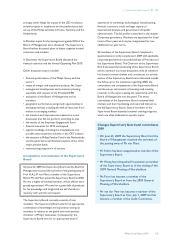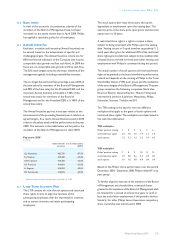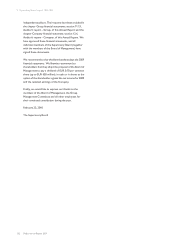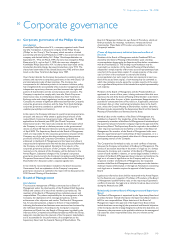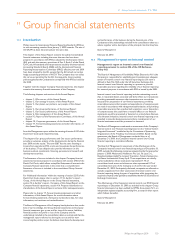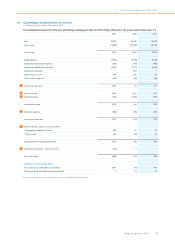Philips 2009 Annual Report Download - page 145
Download and view the complete annual report
Please find page 145 of the 2009 Philips annual report below. You can navigate through the pages in the report by either clicking on the pages listed below, or by using the keyword search tool below to find specific information within the annual report.delivery date, Philips will grant 20% additional (premium) shares,
provided he/she is still with Philips. The Plan is designed to stimulate
long-term investment in Philips shares. To further align the interests of
members of the Board of Management and shareholders, restricted
shares granted to these members of the Board of Management shall be
retained for a period of at least five years, or until at least the end of
employment, if this period is shorter.
The actual number of long-term incentives (both stock options and
restricted shares rights) that are to be granted to the members of the
Board of Management will be determined by the Supervisory Board and
depends on the achievement of the set team targets in the areas of
responsibility monitored by the individual members of the Board of
Management and on the share performance of Philips. The share
performance of Philips is measured on the basis of the Philips Total
Shareholder Return (TSR) compared to the TSR of a peer group of 12
leading multinational electronics/electrical equipment companies over a
three-year period; the composition of this group is described in the
chapter Supervisory Board Report. With regard to stock options the
TSR performance of Philips and the companies in the peer group is
divided into three groups: top 4, middle 4 and bottom 4. Based on this
relative TSR position, the Supervisory Board establishes a multiplier
which varies from 1.2 to 0.8 and depends on the group in which the
Philips TSR result falls. With regard to restricted share rights the TSR
performance of Philips and the companies in the peer group is ranked
from 1 to 12. Based on this relative TSR position, the Supervisory Board
establishes a multiplier which varies from 0.0 to 2.0 and depends on the
TSR position of Philips within the peer group. Every individual grant, the
size of which depends on the positions and performance of the
individuals, will be multiplied by the TSR-multiplier.
The so-called ultimum remedium clause and claw-back clause of best
practice provisions II.2.10 and II.2.11 of the Dutch Corporate
Governance Code is applicable to Annual Incentive payments and LTIP
grants for the year 2009 onwards to all members of the Board of
Management. In respect of the LTIP grants, the ultimum remedium
clause can be applied to the performance-related actual number of
stock options and restricted share rights that is (unconditionally)
granted.
Members of the Board of Management hold shares in the Company for
the purpose of long-term investment and are required to refrain from
short-term transactions in Philips securities. According to the Philips
Rules of Conduct on Inside Information, members of the Board of
Management are only allowed to trade in Philips securities (including the
exercise of stock options) during ‘windows’ of ten business days
following the publication of annual and quarterly results (provided the
person involved has no ‘inside information’ regarding Philips at that
time) unless an exemption is available. Furthermore, the Rules of
Procedure of the Board of Management contain provisions concerning
ownership of and transactions in non-Philips securities by members of
the Board of Management and the annual notification to the Philips
Compliance Officer of any changes in a member’s holdings of securities
related to Dutch listed companies. Members of the Board of
Management are prohibited from trading, directly or indirectly, in
securities in any of the companies belonging to the above-mentioned
peer group of 12 leading multinational electronics/electrical equipment
companies.
Indemnification of members of the Board of Management and
Supervisory Board
Unless the law provides otherwise, the members of the Board of
Management and of the Supervisory Board shall be reimbursed by the
Company for various costs and expenses, such as the reasonable costs
of defending claims, as formalized in the articles of association. Under
certain circumstances, described in the articles of association, such as
an act or failure to act by a member of the Board of Management or a
member of the Supervisory Board that can be characterized as
intentional (‘opzettelijk’), intentionally reckless (‘bewust roekeloos’) or
seriously culpable (‘ernstig verwijtbaar’), there will be no entitlement to
this reimbursement. The Company has also taken out liability insurance
(D&O - Directors & Officers) for the persons concerned.
10.3 Supervisory Board
Introduction
The Supervisory Board supervises the policies of the Board of
Management and the general course of affairs of Philips and advises the
executive management thereon. The Supervisory Board, in the two-tier
corporate structure under Dutch law, is a separate body that is
independent of the Board of Management. Its independent character is
also reflected in the requirement that members of the Supervisory
Board can be neither a member of the Board of Management nor an
employee of the Company. The Supervisory Board considers all its
members to be independent pursuant to the Dutch Corporate
Governance Code and under the applicable US Securities and Exchange
Commission standards.
The Supervisory Board, acting in the interests of the Company and the
Group and taking into account the relevant interest of the Company’s
stakeholders, supervises and advises the Board of Management in
performing its management tasks and setting the direction of the
Group’s business, including (a) achievement of the Company’s
objectives, (b) corporate strategy and the risks inherent in the business
activities, (c) the structure and operation of the internal risk
management and control systems, (d) the financial reporting process,
(e) compliance with legislation and regulations, (f) the operational and
financial objectives, (g) the parameters to be applied in relation to the
strategy, (h) corporate social responsibility issues and (i) the company-
shareholder relationship. Major management decisions and the Group’s
strategy are discussed with and approved by the Supervisory Board. In
its report, the Supervisory Board describes its activities in the financial
year, the number of committee meetings and the main items discussed.
Rules of Procedure of the Supervisory Board
The Supervisory Board’s Rules of Procedure set forth its own
governance rules (including meetings, items to be discussed,
resolutions, appointment and re-election, committees, conflicts of
interests, trading in securities, profile of the Supervisory Board). Its
composition follows the profile, which aims for an appropriate
combination of knowledge and experience among its members
encompassing marketing, technological, manufacturing, financial,
economic, social and legal aspects of international business and
government and public administration in relation to the global and
multi-product character of the Group’s businesses. The Supervisory
Board attaches great importance to diversity in its composition. More
particularly, it aims at having members with a European and a non-
European background (nationality, working experience or otherwise),
one or more female members and one or more members with an
executive or similar position in business or society no longer than 5
years ago. In line with US and Dutch best practices, the Chairman of the
Supervisory Board should be independent pursuant to the Dutch
Corporate Governance Code and under the applicable US standards.
The Rules of Procedure of the Supervisory Board are published on the
Company’s website. They include the charters of its committees, to
which the plenary Supervisory Board, while retaining overall
responsibility, has assigned certain tasks: the Corporate Governance
and Nomination & Selection Committee, the Audit Committee and the
Remuneration Committee. A maximum of one member of each
committee need not be independent as defined by the Dutch
Corporate Governance Code. Each committee reports, and submits its
minutes for information, to the Supervisory Board.
The Supervisory Board is assisted by the General Secretary of the
Company. The General Secretary sees to it that correct procedures are
followed and that the Supervisory Board acts in accordance with its
statutory obligations and its obligations under the articles of
association. Furthermore the General Secretary assists the Chairman of
the Supervisory Board in the actual organization of the affairs of the
Supervisory Board (information, agenda, evaluation, introductory
program) and is the contact person for interested parties who want to
make concerns known to the Supervisory Board. The General
Secretary shall, either on the recommendation of the Supervisory
Board or otherwise, be appointed by the Board of Management and may
be dismissed by the Board of Management, after the approval of the
Supervisory Board has been obtained.
(Term of) Appointment, individual data and conflicts of
interests
The Supervisory Board consists of at least three members (currently
nine), including a Chairman, Vice-Chairman and Secretary. The so-
called Dutch ‘structure regime’ does not apply to the Company itself.
Members are currently elected by the General Meeting of Shareholders
for fixed terms of four years, upon a binding recommendation from the
Supervisory Board. According to the Company’s articles of association,
this binding recommendation may be overruled by a resolution of the
General Meeting of Shareholders adopted by a simple majority of the
votes cast and representing at least one-third of the issued share capital.
If a simple majority of the votes cast is in favor of the resolution to
overrule the binding recommendation, but such majority does not
represent at least one-third of the issued share capital, a new meeting
10 Corporate governance 10.2 - 10.3
Philips Annual Report 2009 145


